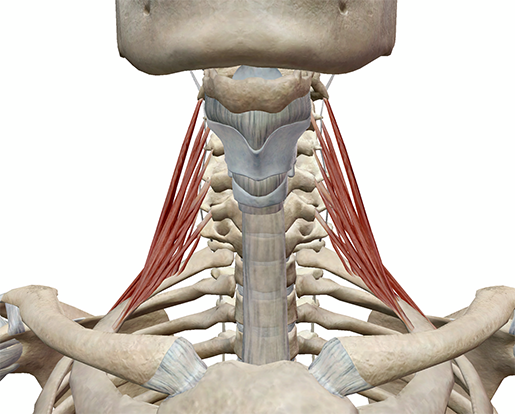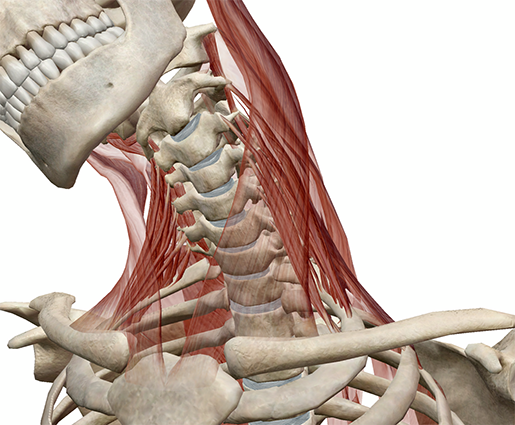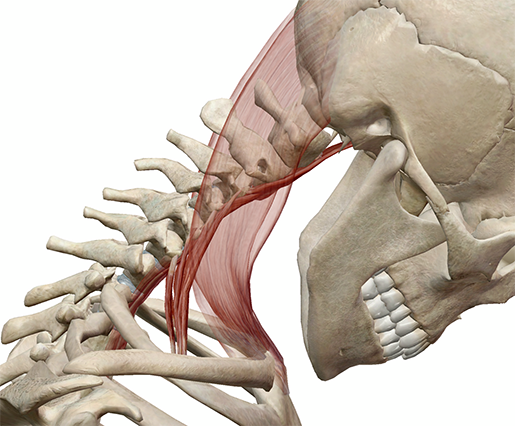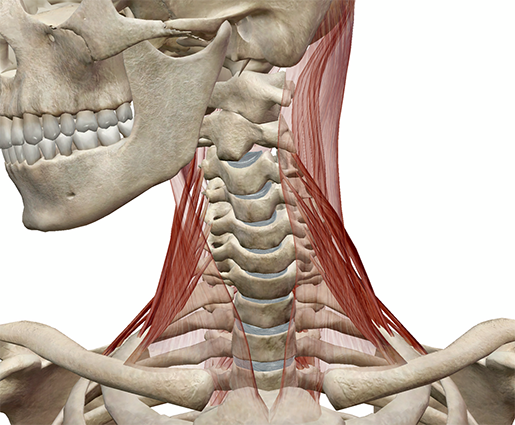Posted on 7/17/13 by Courtney Smith
If you’re like me, you’ll sometimes toss your head from side to side as you sing loudly in your car (alone, with the windows up, of course—I’m not cruel). This action, in which your neck moves from a straight position to a lateral bend, is called lateral flexion, and a group of muscles called the scalenes (or scalenus muscles) help make it happen.
Let’s take a look at them.
The scalenes are muscles of the neck, but are also classified as being in the lateral vertebral region. They are responsible for movements of the vertebral column, as well as aiding in respiration.
 Image from Muscle Premium.
Image from Muscle Premium.
The muscles in this group are:
|
|
Origin |
Insertion |
Actions |
|
Scalenus posterior |
Posterior tubercles of the transverse processes of C05–C07 |
Outer surface of the second rib; occasionally blended with scalenus medius |
Elevates the first and second ribs; bends the spinal column laterally |
|
Scalenus medius |
Posterior tubercles of the transverse processes of C02–C07 |
Upper surface of the first rib |
Elevates the first and second ribs; bends the spinal column laterally |
|
Scalenus anterior |
Anterior tubercles of the transverse processes of C03–C06 |
Scalene tubercle on the inner border and upper surface of the first rib |
Elevates the first and second ribs; bends the spinal column laterally |
Want to learn more about the scalenes and the other neck muscles? Check out our free eBook!
 Scalenes acting in lateral neck flexion. Image from Muscle Premium.
Scalenes acting in lateral neck flexion. Image from Muscle Premium.
The scalenes are involved in a few actions involving the neck, as well as the act of inhalation.
When you move your head from side to side (bending your neck to bring your ear down toward your shoulder) like I do (singing in the car, remember?), this is lateral flexion of the neck. The other muscles involved are the sternocleidomastoid, splenius capitis, splenius cervicis, longissimus capitis, longissimus cervicis, iliocostalis cervicis, intertransversarii anteriores cervicis, intertransversarii posteriors cervicis, and intertransversarii mediales lumborum. Whew!
 Scalenes acting in neck flexion. Image from Muscle Premium.
Scalenes acting in neck flexion. Image from Muscle Premium.
If you look straight ahead, then turn your head to the side, this is contralateral head rotation. The muscles involved include the sternocleidomastoid, rotatores longi, semispinalis capitis, and semispinalis cervicis.
 Scalenes acting in contralateral head rotation. Image from Muscle Premium.
Scalenes acting in contralateral head rotation. Image from Muscle Premium.
In the act of inhalation (breathing in), the scalenes, along with many other muscles (such as the intercostals), help elevate the ribs, while other muscles, like the diaphragm, help to expand the thoracic cavity.
Since the scalenes are so involved in neck movement and rib elevation, they’re quite easy to injure or become irritated, as they’re working all the time.
Whiplash, an injury commonly sustained in car accidents, occurs when your head moves back and then snaps forward (like the crack of a whip), causing distortion of the neck muscles. The scalenes are often strained in cases of whiplash. Rest, ice packs, and limiting movement of the neck will help them heal.
The anterior scalene is involved with scalene myofascial pain, which is chronic regional pain that presents with hyperirritable spots called trigger points and a pattern specific to the muscle involved (in this case, the anterior scalene). Scalene myofascial pain is frequently misdiagnosed as another neck pain–associated radiculopathy. Visiting a professional, such as a chiropractor, for treatment, as well as resting and icing the muscle, can help.
Be sure to subscribe to the Visible Body Blog for more anatomy awesomeness!
Are you a professor (or know someone who is)? We have awesome visuals and resources for your anatomy and physiology course! Learn more here.
When you select "Subscribe" you will start receiving our email newsletter. Use the links at the bottom of any email to manage the type of emails you receive or to unsubscribe. See our privacy policy for additional details.
©2024 Visible Body. All Rights Reserved.